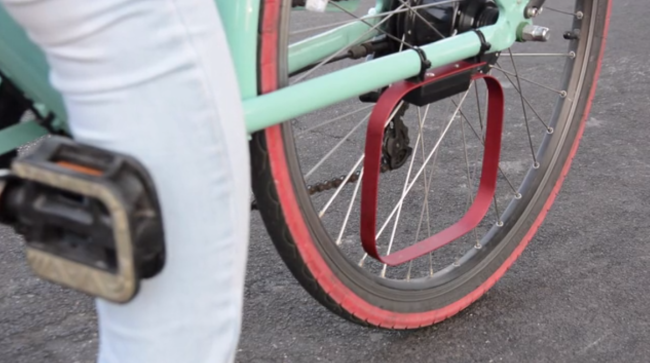
Ever sat at a traffic light on your bike, hopelessly waiting for any car to approach behind you just so the light will turn green? Many cities across the country do not have vehicle detection loops that are properly calibrated for bikes. A new invention called Veloloop looks to circumvent this problem with an attachment for your bike that will trigger traffic sensors just like a car.
Vehicle detection loops, or inductive-loop traffic detectors are used to detect vehicles passing over or arriving at a certain point. An insulated, electrically conducting loop is installed in the pavement with energy running through the wire loops at frequencies between 10 kHz to 200 kHz. When a vehicle passes over the loop or is stopped within the loop, the vehicle induces eddy currents in the wire loops, which decrease their inductance. This decreased inductance alerts the traffic signal controller of the presence of a vehicle.
The relatively crude nature of the loop’s structure means that only metal masses above a certain size are capable of triggering the relay. This is to ensure the loop does not produce false positive triggers (such as by a pedestrian crossing the loop with a pocket full of loose metal change) but it sometimes also means that bicycles, scooters, and motorcycles stopped at such intersections may never be detected by them (and therefore risk being ignored by the switch/signal).
The Veloloop includes two parts—a box of electronics with an anodized aluminum antenna that attaches to your bike and a spoke magnet that tells the unit when your bike is moving. When you stop, the Veloloop rolls into action and starts looking for the inductive-loop traffic detector below by scanning all the frequencies the system may be emitting. Once it locks on to the sensor, it transmits a signal that will trigger the light.
An LED on the Veloloop tells the you if the Veloloop is searching for a sensor (flashing red LED) and when it is locked on and triggering the sensor (solid red LED). Using a patented circuit, the Veloloop triggers the sensor using very low power, so a pair of AAA batteries can power the Veloloop for a year or more.
While the traffic signals in the Bay Area generally do a good job at detecting bikes, there still remain quite a few that don’t. I would be interested to hear from people who ride in cities where the signals are notorious for not recognizing bikes and whether you would use something like this.
For a $99 Kickstarter pledge, you can be one of the first owners of Veloloop. Estimated delivery is January 2015.
